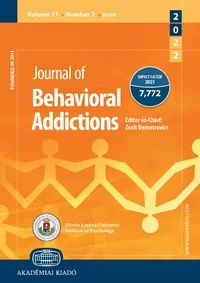Think-aloud analysis of commonly used screening instruments for Internet use disorders: The CIUS, the IGDT-10, and the BSMAS
Think-aloud analysis of commonly used screening instruments for Internet use disorders: The CIUS, the IGDT-10, and the BSMAS
Author(s): Hannah Schmidt, Dominique Brandt, Anja Bischof, Silja Heidbrink, Gallus Bischof, Stefan Borgwardt, Hans-Jürgen RumpfSubject(s): Behaviorism
Published by: Akadémiai Kiadó
Keywords: CIUS; IGDT-10; BSMAS; screening instruments; think-aloud interview; content validity
Summary/Abstract: Background. Despite the constant publication of new screening instruments for Internet use disorders (IUD), little is known about their content validity. This study aimed to identify potential mismatches between the items' intention and young adults' interpretation of these items when answering three screening instruments that are commonly used in research and clinical settings: The Compulsive Internet Use Scale (CIUS), the 10 Item-Internet Gaming Disorder Test (IGDT-10), and the Bergen Social Media Addiction Scale (BSMAS). Methods. In total, 30 vocational students (50% female, age = 21.3; SD = 2.1) took part in individual think-aloud interviews. All participants were asked to report their thoughts while completing the CIUS. In addition, participants who reported online games (OG) as their main Internet activity (n = 11) answered the IGDT-10. Participants who reported social networks (SN) as their main Internet activity (n = 18) answered the BSMAS. One participant used OG and SN equally and completed both screening instruments. All interviews were audio-recorded, transcribed, and content-analysed. Results. Overall, four potential sources for errors were identified: (1) High scorings were often not congruent with the underlying diagnostic criteria. In particular, such discrepancies were found in items aimed to assess dysfunctional emotional regulation strategies and cognitive involvement. (2) Some participants were uncertain which time frame or Internet activity should be considered in their answers. (3) Long and complex items led to the building of mean values or the choice of the middle answer category. (4) Some wordings were perceived to be outdated and difficult to understand. Discussion. These findings might help to provide recommendations on how to improve screening instruments for IUD. Most important, items should more clearly distinguish between Internet use as a “normal” leisure activity and Internet use that leads to functional impairments in daily life.
Journal: Journal of Behavioral Addictions
- Issue Year: 11/2022
- Issue No: 2
- Page Range: 467-480
- Page Count: 14
- Language: English

